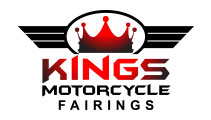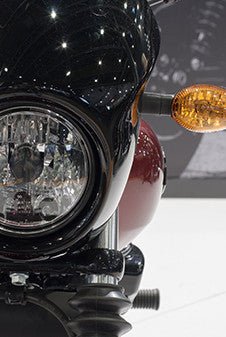News » article
-
Perfect Motorcycle Fairing Kit & Helmet Combinations
Perfect Motorcycle Fairing Kit & Helmet Combinations by KingsMotorcycleFairings.com
When it comes to customizing your motorcycle, the right fairing kit and helmet combo can make all the difference. Whether you want a cohesive theme, a mix of bold patterns, or a striking half-and-half design, KingsMotorcycleFairings.com has you covered. Here are some top-tier ideas to inspire your next look.
1. Theme-Based Elegance
For riders who love a refined and artistic touch, a theme-based combination is the way to go. A sleek white and pink cherry blossom fairing kit paired with a white helmet—a perfect balance of minimalism and beauty. This setup is ideal for those who want a stylish, cohesive look that stands out while maintaining an elegant aesthetic.
2. Bold Patterns & Solid Contrasts
If you love dynamic and eye-catching designs, mixing a fun pattern with a solid helmet is a winning formula. A black, white, and gold honeycomb fairing kit combined with a sleek black helmet exudes confidence and sophistication. The solid helmet allows the patterned fairing to shine while maintaining a balanced look.
3. Half & Half – Best of Both Worlds
For those who want contrast and versatility, a half black, half blue fairing kit is a fantastic choice. Pair it with a black and blue helmet for a perfectly matched aesthetic, or opt for a solid black or blue helmet for a more subtle take. This combination strikes the perfect balance between edgy and coordinated.
Ride in Style with KingsMotorcycleFairings.com
Your motorcycle is an extension of yourself, and the right fairing kit and helmet combination can elevate your entire riding experience. Whether you prefer a sleek theme, a bold pattern, or a balanced half-and-half look, there's a perfect match for you. Check out KingsMotorcycleFairings.com for premium fairing kits that will turn heads wherever you ride. Gear up, hit the road, and ride in style!
Upgrade the look of your motorcycle and riding gear by shopping for new motorcycle Fairings, Helmets,
Boots , Goggles, Exhaust Mufflers, Top Boxes, Gloves, Backpacks, Accessories and more at KingsMotorcycleFairings.com! -
Sport Bike Upgrades for Performance & Style
Sport Bike Upgrades for Performance & Style by KingsMotorcycleFairings.com
For many riders, a sport bike is more than just a machine—it’s an extension of their personality and passion for the road. Whether you're looking to boost performance or give your bike a custom look, modifying your sport bike can enhance both speed and style. Here are some key upgrades to consider.
Performance Upgrades
1. Exhaust System: Swapping out the stock exhaust for an aftermarket system can increase horsepower, improve throttle response, and give your bike a more aggressive sound.
2. Air Intake & Fuel Mapping: Upgrading the air filter and tuning the fuel injection system ensures optimal airflow and combustion, leading to improved performance and efficiency.
3. Suspension & Brakes: Adjustable suspension components enhance handling, while upgraded brake pads and stainless-steel lines improve stopping power for better control at high speeds.
4. Lightweight Wheels & Tires: High-performance tires and lightweight wheels reduce rotational mass, resulting in better acceleration, braking, and cornering.
Aesthetic & Comfort Modifications
1. Custom Fairings: Installing aftermarket fairings from KingsMotorcycleFairings.com not only gives your bike a unique and aggressive look but also improves aerodynamics and protection.
2. LED Lighting: Upgrading to LED headlights and accent lights not only enhances visibility but also adds a modern, sleek touch.
3. Seat & Ergonomics: A customized seat can improve comfort on long rides, while adjustable rear sets and handlebars ensure a more personalized riding position.
Final Thoughts
Upgrading your sport bike allows you to tailor performance and aesthetics to your personal preferences. Whether you’re chasing speed, control, or a head-turning look, investing in high-quality modifications ensures a better riding experience. Check out KingsMotorcycleFairings.com for premium aftermarket fairings and accessories. Ride safe and enjoy the journey!
Upgrade the look of your motorcycle and riding gear by shopping for new motorcycle Fairings, Helmets,
Boots , Goggles, Exhaust Mufflers, Top Boxes, Gloves, Backpacks, Accessories and more at KingsMotorcycleFairings.com! -
Top Fairing Color Combinations for 2025
Top Fairing Color Combinations for 2025 by KingsMotorcycleFairings.com
When it comes to motorcycle fairings, colors do more than just make your bike look cool. The right color combination can elevate your ride’s entire aesthetic, make a bold statement on the road, and even boost resale value. At KingsMotorcycleFairings.com, we know how important it is to stay ahead of the trends. That’s why we’ve rounded up the top fairing color combinations for 2025 to inspire your next custom look.
1. Matte Black & Blue
Sleek and aggressive, matte black fairings paired with electric blue accents are a favorite among sportbike riders. The contrast creates a sharp, futuristic vibe that’s perfect for those who want to stand out without going over the top. Plus, this combination pairs well with a variety of aftermarket decals and accessories.
2. Gloss Black & Red
For a sleek and sporty look, gloss black paired with bold red accents is a timeless combination. The deep, shiny finish of black with striking red highlights makes a powerful visual impact – perfect for riders who want to turn heads.
3. Neon Green & Black
A classic combo that never goes out of style, neon green and black fairings scream speed and energy. Perfect for those who love high-performance rides and bold designs, this combination remains a top choice for track and street riders alike.
4. Nardo Gray & Red
For a sophisticated, understated look with a pop of color, Nardo gray paired with red accents is the perfect choice. The gray base gives a modern, refined aesthetic, while the red adds just the right amount of intensity and vibrancy.
5. Nardo Gray & Yellow
Nardo gray fairings provide a subtle, understated base, while bright yellow accents add a pop of energy and visibility. This combination is perfect for those who want a modern, edgy design that’s also highly visible on the road.
Customize Your Ride with KingsMotorcycleFairings.com
No matter your style, KingsMotorcycleFairings.com has the perfect fairing kits to help you achieve your dream look. With a wide range of customizable options and high-quality materials, we make it easy to stand out from the crowd. Whether you’re going for bold contrasts or subtle elegance, we’ve got you covered.
Ready to transform your bike? Check out our latest fairing kits and design your ride to match the trends of 2025. Let’s turn your vision into reality!
Upgrade the look of your motorcycle and riding gear by shopping for new motorcycle Fairings, Helmets,
Boots , Goggles, Exhaust Mufflers, Top Boxes, Gloves, Backpacks, Accessories and more at KingsMotorcycleFairings.com! -
How to Store Your Motorcycle in the Off-Season
How to Store Your Motorcycle in the Off-Season by KingsMotorcycleFairings.com
As the riding season winds down, proper storage is essential to keeping your motorcycle in top condition for next year. Taking the time to prepare your bike, from the engine to the fairings, helps prevent damage and ensures a smooth transition back to the open road when the weather warms up. Whether you're a seasoned rider or storing your bike for the first time, these essential tips will help protect your investment and get your bike ready to roar back to life.
1. Clean Your Bike Thoroughly
Before you tuck your bike away, give it a thorough wash to remove dirt, grime, and any road salt. Don’t forget to clean and lube the chain to prevent rust. A clean bike will stay in better condition during storage.
2. Change the Oil and Top Off Fluids
Old oil can leave contaminants in your engine, so change the oil before storing your bike. Also, check and top off other fluids like coolant, brake fluid, and gas to prevent moisture buildup.
3. Fuel Care
If you’re storing your bike for a while, consider adding a fuel stabilizer to your tank. This helps prevent the gas from breaking down and clogging your fuel system.
4. Protect Your Battery
Disconnect the battery to prevent it from draining. Store it in a cool, dry place, and consider using a battery tender to keep it in top shape during the off-season.
5. Cover Your Bike
A good quality cover will protect your bike from dust, moisture, and temperature fluctuations. Make sure it’s breathable to avoid moisture buildup underneath, which could lead to rust or mildew.
6. Choose the Right Storage Space
Store your bike in a dry, cool space away from direct sunlight. If you're using a garage or shed, elevate your bike off the ground using a stand to prevent flat spots on the tires.
Proper off-season storage is key to preserving your motorcycle's performance and extending its lifespan. By following these straightforward steps, you can ensure your bike is in prime condition and ready to hit the road when the next riding season begins. Thank you for reading—we hope you found this article helpful. For more tips and quality motorcycle parts, visit KingsMotorcycleFairings.com.
Upgrade the look of your motorcycle and riding gear by shopping for new motorcycle Fairings, Helmets,
Boots , Goggles, Exhaust Mufflers, Top Boxes, Gloves, Backpacks, Accessories and more at KingsMotorcycleFairings.com! -
The Impact of Aerodynamics: How Fairings Enhance Performance
The Impact of Aerodynamics: How Fairings Enhance Performance by KingsMotorcycleFairings.com
When it comes to motorcycle performance, every detail counts, and fairings play a crucial role in boosting aerodynamics. Unlike cars, motorcycles expose riders directly to the elements, which can lead to drag that slows down the bike and makes handling more challenging. Fairings work to streamline this interaction with air, reducing drag and enhancing both speed and stability.
How Fairings Reduce Drag
Motorcycle fairings are designed to cut through the wind, allowing for smoother airflow around the bike and the rider. By minimizing turbulence, fairings reduce the energy required to maintain higher speeds, meaning that riders can go faster with less throttle. This reduction in drag doesn’t just benefit racers; even casual riders will notice improved fuel efficiency and a smoother ride at higher speeds.
Enhancing Stability and Control
Fairings also impact handling by balancing air pressure across the bike, which enhances stability. In windy conditions, a well-designed fairing keeps the bike steady, preventing the rider from being buffeted around by strong gusts. This leads to a more comfortable and controlled ride, especially during long highway stretches or at high speeds.
The Performance Benefits for Every Rider
While race bikes often use fairings for maximum speed, fairings also benefit day-to-day riders with improved fuel economy, less wind fatigue, and a smoother, safer experience on the road. Whether you're a weekend rider or a daily commuter, adding or upgrading your motorcycle’s fairings can make a noticeable difference in performance and comfort.
Conclusion
Fairings are more than just a sleek addition to your motorcycle—they’re an essential component for enhancing performance through aerodynamics. By reducing drag and increasing stability, fairings help riders make the most of every journey.
Upgrade the look of your motorcycle and riding gear by shopping for new motorcycle Fairings, Helmets,
Boots , Goggles, Exhaust Mufflers, Top Boxes, Gloves, Backpacks, Accessories and more at KingsMotorcycleFairings.com!
































kingsmotorcyclefairings.com